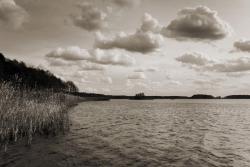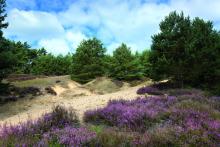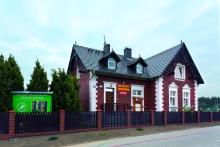 Asset Publisher
Asset Publisher
HISTORY
Going back to the past of the lands' history, which belongs to the Forest District Sława Śląska, we can encounter information dated from the XIII century. In those days, lands were divided into castellanies, within the framework of which, among others, there was conducted the forest management. The historians mention facts connected with numerous hunting having taken place in that time and the meetings of magnates in the area of Bory Tarnowskie (Tarnów Forests), which in greater extend constitute some part of the current forests of the Forest District.
The first mentions comes from the XII century already. In one of the documents, we can find the writing dated on July 28, 1213 telling, that today's Tarnów Jezierny was to be a kind of tithe granted by the bishop Lorenz to the Monastery in Lubiąż. Little is known about "the forestry" carried out on local lands. One of the most important messages is the note from 1291 about issuance of permission by Henry III, Duke of Głogów for obtaining the wood, which were to be used to rebuilt burnt down Głogów. From information from 1293, we can learn about imposing the tributes on local villages, due to the fact of necessity of the foundation stone, that was laid under the church in Tarnów. Further mentions appear in well known chronicle by Marcin Kromer, who describes there the accident of Konrad, the son of Henry I the Bearded, that happened during hunting.
Really interesting thing is also the fact, that in the XVII century in Kolsk, there took place witch trials, and in the effect many people were tortured as suspected of practising witchcrafts, and finally burned on stake.
Much more information on Sława appears not until the first half of the XX century. Then we can find writings from 1939 demonstrating, that 1901 ha of forests were included into land estate in Sława ( with the overall area of 3453 ha). Within the interwar period, the attractiveness of Sława and neighbouring area has significantly grown. It happened due to opening the railway line Głogów-Sława-Sulechów, what made access to Sławskie Lake considerably easier, yet known as Śląskim Morzem (Silesian Sea - Schlesiersee). The fact of starting up the next railway line Sława-Wschowa resulted in the increase of tourist movement. Besides, in the former tourist guides, Sława was mentioned as the health resort.
During the Second World War within the area of today's Sub-District Sława, in the village Stare Strącze, inhabited then by German settlers, in 1944 in manorial farms - Neuvorwerk and Banisch Vorwerk, there were established sub-camps of concentration camp Gross – Rosen. In 1945, after the invasion of Red Army, Germans evacuated from these lands or were displaced by polish authorities after the war time.
First mentions about activities of the Forest District Sława Śląska come from the second half of 1945, in July of this year Edward Wójcik and the Sub District Forest Manger Jan Karolczyk organised the Forest District Offices in 38 Dworcowa Street, in Sława. At the same time, working on behalf of the Directorate of the State Forests in Poznań, Bronisław Metzger opened the first post-war Sława sawmill.
The Forest District in Sława took part in public life of post-war Sława. The proof for that was the International Day of the Forest organised on 27th April. During that day the District Forest Manger gave the relevant speech, and the whole event resulted in the common tree saplings planting. Very important historical event in the history of Sława forests was establishment of Trade Unions of Forest Workers and of Forest Industry on 12th May 1946. The first chairman of the Trade Unions was the sawmill manger Bronisław Metzler.
Until 1945, the forests included in the part of current Forest District were in great extend a private property of landed estates. As the result of war acts, forests surrounding Sława were seriously destroyed. That is why, in the first years after the end of the war, the work of foresters was mainly based on cleaning destroyed forest stands (damaged during the war) and planting the new ones, both in cut out places, as well as within former agrarian grounds, constituting idle lands so far.
In those days, forestry was based on provisional tables of the age classes. Fundamental way of development was then the way of felling site within the 5 years cycle of cuttings. Forest renewal was carried out in almost completely in artificial way. The nursing of soil in newly set up cultivations done mainly by hands – forest and farm scythes or sickles. Subject matters and methods of running forestry of these times are expressed in famous piece of work "Siekieryzada" or "Zima leśnych ludzi" written by Edward Stachura.
In the sixties of the XX century, Edward Stachura spent his time in the Forests of the Forest District Sława Śląska. Altogether with his wife, they visited his friend Jan Czopik-Leżachowskiin the village Kotla. His visit in then Lubuskie Province wasn't restricted only to looking for literary inspiration. Stachura took up work as the helper of the woodcutter during the forest fell. His "working" experience was immortalized by him on the slips of "Siekieryzada", action of which, he moved into quite different area of the country, characters were followed on real people's examples and on people who surrounded him. Up today, in Grochowice (literary Bobrowice), there is cottage house of grandma Oleńka, where he really lived. Although, we won't find legendary bar Hoplanka in Hopla (in real village Kotla), where one the most distinguished and excellent character staggered, tasted "jelly and pork knuckle", we can admire great dialogues with famous words "about spike in the a....." , excellently presented in 1985 by the creators of movie adaptation of the work.
In current shape the Forest District Sława Śląska has been functioning since January 1, 1979. At the beginning it consisted of 24 Forest Rangers Areas, which changes their areas and territorial range to create today's 14 Forest Rangers Areas with its area covering almost 26 thousand hectares.


 Historia, fot. Krzysztof Moroz
Historia, fot. Krzysztof Moroz
 Historia, fot. Krzysztof Moroz
Historia, fot. Krzysztof Moroz



